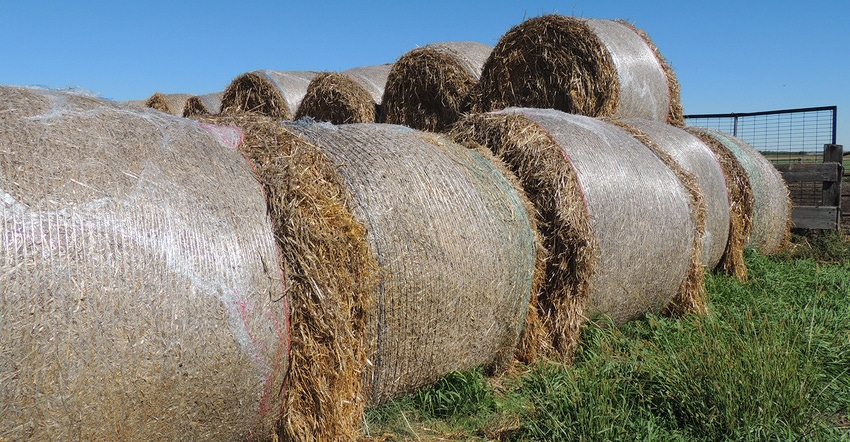January 6, 2017

Although it is OK to leave twine on a bale when feeding or grinding the bale, don’t leave net wrap on a bale, advises Taylor Grussing, South Dakota State University Extension cow-calf field specialist.
"Net wrapping is newer and the effects on cattle consumption are relatively undocumented," she says. "When net wrap is not removed prior to feeding whole bales or grinding, there is a potential risk for cattle to ingest the net wrap along with the forage."
In 2008, veterinarians at University of Nebraska-Lincoln and across the state reported large volumes of twine accumulation in rumens upon post-mortem evaluations of beef cattle.
North Dakota State University diagnosed net wrap ingestion as the cause of an unexpected death in a feedlot heifer. A 2014 follow-up study looked at net wrap digestibility compared to sisal and biodegradable twine. After 14 days of incubation in rumen cannulated steers, 70% of sisal twine disappeared while none of the net wrap and biodegradable twine was degraded.
"Since net wrap does not appear to be digested in the rumen, it can accumulate, which may have implications on production efficiency and animal health if the digestive system is compromised," Grussing says.
The highest risk occurs when whole net-wrapped bales are offered on cow-calf operations. However, there is also potential for net wrap to accumulate even if particle size is decreased when utilized as tub ground hay.
"Risk of loss is likely related to how much opportunity cattle have to consume net wrap," Grussing says. "Cows fed exclusively long hay in net-wrapped bales from bale feeders would likely be at the greatest risk."
Feedlot cattle fed a high-concentrate diet would have much less exposure, but could still accumulate significant amounts of net wrap.
While it may not be possible to remove all net wrap, Grussing says it's important to try, especially when feeding whole bales.
She offers these tips
Net wrap removal can be done using a simple pocket knife or hot knives that are available for the more tangled mess. "Hot knives are especially handy in the winter when net wrap can freeze onto bales, making it more difficult to remove," Grussing says.
When grinding bales, cattle producers likely won't be able to cut off net wrap as they go, so Grussing encourages them to prepare for the grinder a couple of days ahead by removing net wrap from a few bales each day. "This method may allow you to get half of the net wrap off bales to be ground, which will result in less accumulation in the pile," she says.
If producers choose not to remove net wrap prior to feeding, Grussing suggests that they at least pick it up and throw it away after the bale is gone. "Cattle get bored and like to chew on things, so they will eat net wrap if it's lying around," Grussing says. "Taking the time to pick up net wrap in and around bale feeders is a simple way to reduce the chances of ingestion."
If you have questions on net wrap ingestion or how to conduct post-mortem evaluations, contact your herd veterinarian or an Extension field specialist.
Source: NDSU
About the Author(s)
You May Also Like




